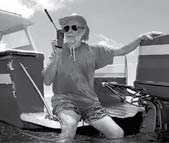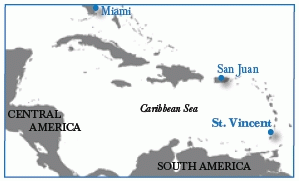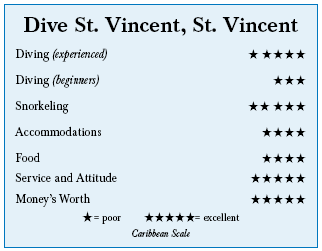Dive St. Vincent, St. Vincent & The GrenadinesContents of this Issue: Dive St. Vincent, St. Vincent & The Grenadines Register for Your Free Online Membership Diver Drifts 12 Hours in Somosomo Strait Serious Diver Impact on the Red Sea Sipadan’s Dive Permit System Keeps Some Divers Out of Its Waters When Bad Air is Pumped into Your Tank Diver Loses Fingers on the Dive Ladder What You’ll Pay on Your Next Dive Trip The Aggressor and Peter Hughes Fleets: Now Under One Owner Editorial Office: Ben Davison Publisher and Editor Undercurrent 3020 Bridgeway, Suite 102 Sausalito, CA 94965 the Caribbean capital of muck diving from the January, 2009 issue of Undercurrent
Dear Fellow Diver: “Muck diving” was a term coined by Bob Halstead when he piloted his liveaboard Telita in Papua New Guinea. Some say by advocating for the unique critters in the shallows, he didn’t have to burn fuel to motor to beautiful reefs. Of course, Halstead would disagree. Regardless, muck diving caught on and now there’s an entire industry in PNG and Indonesia devoted to photographing tiny and unusual critters, many of which live in otherwise boring environs. But you don’t have to travel half a world away for critter diving. On St. Vincent lives the sharpest-eyed guide in the Caribbean, Bill Tewes (pronounced “twos”), who just happened to cut his teeth guiding divers at Jais Aben Resort in PNG nearly 30 years ago, before coming to St. Vincent. Bill’s a character, a curmudgeon who can rub people the wrong way. He snapped at me because I peered into his personal Pelican box to take a look at his Paul Humann critter book without asking permission. But he does know his critters, everything about their habits and where they live. And he runs an excellent dive operation – he and his divemasters are eager to point out anything and everything of interest. They take great pride in “their” island.
I am a nudibranch nut,
so Bill took me to Bottle
Reef, where I went faceto-
face with some uncommon
spotted sea hares, some of
them coupling, and several
inch-long leech headshield
slugs. A mostly black headshield
slug one diver found
was not mentioned in any fish
ID book at the dive shop.
Among the common lettuce sea
slugs was a tiny green nudi
that had Bill and me baffled.
Even though he has dived
every nook and cranny around St. Vincent countless times, Bill says that
weekly he finds something new or rare. This is not your typical Caribbean dive trip, cruising the corals and swimming with reef fish. An array of the unusual, the bizarre and the unidentified are a recurring experience on nearly every dive. Yes, there are lots of fish (about 260 have been identified) but large schools are lacking. This is where the little stuff is, goodies for those with the patience and keen eyes to find them. Unlike muck diving in some of the Indo-Pacific, the sandy bottom here is not black and critters don’t hide in trash. Of the 30 dive sites, 10 are strictly for seeking rare critters found in Paul Humann’s fish ID books -- and lots that haven’t made it into the books yet. Speaking of Paul Humann, he brings a REEF group to dive with Bill Tewes at least once a year and invariably makes new discoveries. Occasionally, visiting divers have the same good luck. On my first trip to St. Vincent six years ago, I got to brag about seeing six new species of crabs. I went for nine days in late August, in the middle of hurricane season, but while storms were churning a few hundred miles away, here it was partly cloudy and the seas stayed calm. St. Vincent and the Grenadines are in the southern edge of the hurricane belt, and the last time they got a direct hit was in 1955. Most of the diving is in protected coves, anyhow. St. Vincent is the largest of 30 mostly uninhabited islands in an archipelago north of Grenada, with a population of 25,000, but that’s hard to believe because everyone lives tucked away in its lush mountains. Flying in was a breeze. I took Delta to San Juan and had no problems with my LIAT connection to St. Vincent. I was able to check my two bags all the way through and they both arrived when I did. And Bill’s man Paul, the “new guy” with three years at the dive shop, was waiting for me at the gate. I booked my trip with Dive St. Vincent, which offers various packages at different hotels. I picked the 20-room Mariners Hotel, whitewashed with verandahs facing the yachts anchored in Villa Bay. My room’s view was across a palmed garden and a pool to the open water. It was not luxurious, but roomy and comfortable enough and, most importantly, air-conditioned. A couple of miles away, the small capital of Kingston, a bit grubby, offers a foot tour of 19th-century buildings built with bricks brought to the island as ballast in vessels that would voyage back to Europe filled with sugar and molasses. St. Vincent has no high-rises and the largest hotels have about 30 rooms. The Mariners Hotel’s breakfast was the usual island fare: fresh fruits, excellent coffee, a delicious cinnamon toast resembling johnny cakes. Its restaurant, the French Verandah, is a popular gathering place. While the French-born chef offers escargot in garlic butter and beef tenderloin with Roquefort sauce, the meals were mediocre (entrees come with French fries) but thanks to the 20-percent meal discount from Bill’s dive package, the food was a good buy. The waterfront restaurants are all within a short walk from the hotel. The Seafarers Inn has a large menu with hearty American fare, from fish and pizza to burgers and steaks. In the opposite direction, a couple of doors along the quay, the Lemon Tree has uneven service but pretty good seafood. Farther along is a modest place specializing in curried mutton and goat -- the best I’ve eaten in the Caribbean. Right next to the dive shop is an open-air pavilion serving only basics like hamburgers and hot dogs, with the best beer prices around. Everywhere on St. Vincent, I found nothing but friendliness, warm hellos and handshakes. One night, I savored a Scottish stout at the pavilion while watching locals perform karaoke. Bill’s three boats take a maximum of eight divers (a group of six is guaranteed
its own boat) but there were usually only two or three on my dives, which were done from the recently overhauled 28-foot
cabin cruiser that holds enough gear
for two dives. It was a friendly crew,
careful with camera gear (but there was
no rinse tank or camera table). After picking up divers at Young Island across the narrow strait, we shoved off for the first dive around 9:30 a.m. Crew switched over the steel tanks, filled to 2500 p.s.i., during on-board surface intervals. Bill doesn’t offer Nitrox but because dive sites average 30 feet maximum, my bottom time with air typically exceeded 100 minutes. The two morning dives were back-to-back, so it was easy to be out for five or six hours. Most dive sites were in small coves and bays along the southwest coast. There are some coral heads and small reef structures on the coastal rocks but most of the terrain is sandy with grassy areas sloping away from shore. Water averaged 83 degrees, compared to the late August heat and humidity, and visibility ranged from 60 to 75 feet. Dive gear excluding wetsuits and booties was stowed in net bags back at the dive shop so that it was set up in the morning for the first dive. Bill usually takes the two morning dives, while one of his expert divemasters will do a late afternoon and/or night dive if someone requests it, even if it’s just one diver. I was the only one aboard for one night dive and I heard no carping from Bill, and this was when fuel prices were at their highest. I was fortunate to do night dives with Callie, who was careful, knowledgeable, and as good a spotter as his boss (sorry, Bill). At Bottle Reef, the night critters were all out for after-hours cavorting. Many octopuses scoured the bottom, and massive clusters of lobsters looked like they were having orgies. Lots of reef fish and several morays were out, but one highlight was coming across a field of Magnificent sea urchins. They’re normally deep-water creatures, so it’s rare to see even one. But the same peculiar environmental conditions that make diving St. Vincent so special also lead to the migration of these denizens of the depth to shallower waters at night. For a few days, I dived with a couple and their 12-year-old son who had been there five times before. The boy was uncanny at finding small stuff. He located a yellow frogfish resting on top of, what else, a yellow tube sponge, while everyone else had passed right over it. It was his mom, however, who found the “algae crab,” a recent discovery named by another of Bill’s divers the week before. She was looking for seahorses at 20 feet when she noticed a small, leafy algae plant starting to move sideways, and not from wave action. A closer look with the magnifying glass revealed a piece of the “algae” walking across a leaf and then jumping to another. Paul Humann was excited when the photos were e-mailed to him. Then there was the couple who became my dive buddies later in the week. The man was a new diver with lousy buoyancy control. His tiny wife had better skills but was reluctant to make any changes and chattered incessantly. Bill scowled; I’m sure he tires of trying to teach divers who should know better, and it doesn’t take much to stretch his patience. Even underwater, her talking never ceased -- the indistinct moans from her regulator must have puzzled the fish to no end. Usually it was to point out an obvious critter everyone had already seen. Common reef inhabitants had to do something amazing to grab the attention of muckfocused divers. I saw the Caribbean reef octopus on nearly every dive, and at New Guinea Reef one had a lively fight with a gold-spotted eel. The octopus managed to retreat into an opening in a coral shelf but the eel was determined. It always backed out, looking bewildered, but then went in for more punishment. The eel finally gave up and stuck its head into another hole looking for an easier meal. An uncommon broad-banded moray wandered around with me on a morning dive, while a chain moray would only come halfway out of its hiding place. A viper moray and purple-mouth moray were anti-social, extending only their heads from the reef. Most dive areas in St. Vincent are nurseries swarming with multi-colored juveniles and small reef fish. Pipefish, in particular, thrive here. At New Guinea Reef, I saw whitenose pipefish, a shortfin pipefish and two rare pipefish horses, a sort of transition species between a pipefish and a seahorse that goes unlisted in the fish ID books. Flying gurnards, similar to sea robins, were on nearly every dive and in large numbers, either “walking” on the bottom looking for tidbits in the sand, or “flying” above the sea floor looking for mates. The terminal males couldn’t care less about being photographed head-on, a nearly impossible pose to get elsewhere. Regarding those crabs I helped “discover” six years ago, I was happy to see that they were still there, at Turtle Bay, and now included a tiny swimming crab an inch and a half around that burrowed into the sand if disturbed. Scattered among huge slabs of volcanic rock that had tumbled from the cliff were an enormous clinging crab, anemone crabs, a southern teardrop crab and a rare sculptured slipper lobster. I got my dose of crustacean. Diving at other Caribbean islands no longer holds any appeal for me. Give me rarities like the nearly invisible algae fish, flying gunnards and the black brotula that bears live young. What makes a diver appreciate marine life more than when he has to seek it out with patience and good eyesight? If you’ve got a passion for critters or you’re looking for a macro photography paradise, not only will Bill Tewes and Dive St. Vincent fulfill your requirements, they’ll spoil you for any other Caribbean diving. And St. Vincent has a lot more to offer above sea level. Lush rainforests, a climb up the 4,000-foot volcano Mt. Soufriere (Bill can arrange a guide), interesting Botanical Gardens, and that oldfashioned island culture. If you don’t like hanging out on the funky but very charming main island, there’s always posh Young Island, a free, five-minute boat ride away. And Bill will pick you up there. -- W.K.
|

I want to get all the stories! Tell me how I can become an Undercurrent Online Member and get online access to all the articles of Undercurrent as well as thousands of first hand reports on dive operations world-wide
| Home | Online Members Area | My Account |
Login
|
Join
|
| Travel Index |
Dive Resort & Liveaboard Reviews
|
Featured Reports
|
Recent
Issues
|
Back Issues
|
|
Dive Gear
Index
|
Health/Safety Index
|
Environment & Misc.
Index
|
Seasonal Planner
|
Blogs
|
Free Articles
|
Book Picks
|
News
|
|
Special Offers
|
RSS
|
FAQ
|
About Us
|
Contact Us
|
Links
|
3020 Bridgeway, Ste 102, Sausalito, Ca 94965
All rights reserved.


 On
another day, he showed me a black, spindly
crab that lives in black hydras it picks
apart to decorate its body for camouflage.
It wasn’t in any of the fish ID books, so we
named it a “hydra crab.”
On
another day, he showed me a black, spindly
crab that lives in black hydras it picks
apart to decorate its body for camouflage.
It wasn’t in any of the fish ID books, so we
named it a “hydra crab.” I backflipped
off and got back onboard via
a short ladder climb after doffing my
fins. Most dive sites were a half-hour
boat ride from the dive shop, and the
twin 200HP outboards got us there pronto.
Two speedboats, a 28-foot speedboat
with twin 200-hp motors and a 32-foot
speedboat with twin 250s, have folding
canopies and are put into service as the
volume of divers requires.
I backflipped
off and got back onboard via
a short ladder climb after doffing my
fins. Most dive sites were a half-hour
boat ride from the dive shop, and the
twin 200HP outboards got us there pronto.
Two speedboats, a 28-foot speedboat
with twin 200-hp motors and a 32-foot
speedboat with twin 250s, have folding
canopies and are put into service as the
volume of divers requires. Diver’s Compass: Dive St. Vincent offers seven-night dive packages at
seven different hotels, with 10 dives, airport transfers, all dive
equipment; prices range from $772 at the Fitness Quest Apartment/Hotel
to $2,800 at Young Island Resort, on its own island with complimentary
water taxi and all meals included . . . My Mariners Inn package,
which also offered full breakfast and 20 percent off all dinners, was
$1,150 . . . LIAT is the only airline serving St. Vincent, and the
prop jets have no baggage weight restrictions . . . Connections with international flights are in Barbados, Grenada, San Juan and Trinidad; round-trip airfare
from San Juan is around $400 . . . July to November is rainy season, with showers
expected on most days . . . English is the official language, and the Eastern Caribbean
Dollar is $2.60 to US$1 . . . The water is safe to drink . . . Web sites: Dive St.
Vincent:
Diver’s Compass: Dive St. Vincent offers seven-night dive packages at
seven different hotels, with 10 dives, airport transfers, all dive
equipment; prices range from $772 at the Fitness Quest Apartment/Hotel
to $2,800 at Young Island Resort, on its own island with complimentary
water taxi and all meals included . . . My Mariners Inn package,
which also offered full breakfast and 20 percent off all dinners, was
$1,150 . . . LIAT is the only airline serving St. Vincent, and the
prop jets have no baggage weight restrictions . . . Connections with international flights are in Barbados, Grenada, San Juan and Trinidad; round-trip airfare
from San Juan is around $400 . . . July to November is rainy season, with showers
expected on most days . . . English is the official language, and the Eastern Caribbean
Dollar is $2.60 to US$1 . . . The water is safe to drink . . . Web sites: Dive St.
Vincent: 